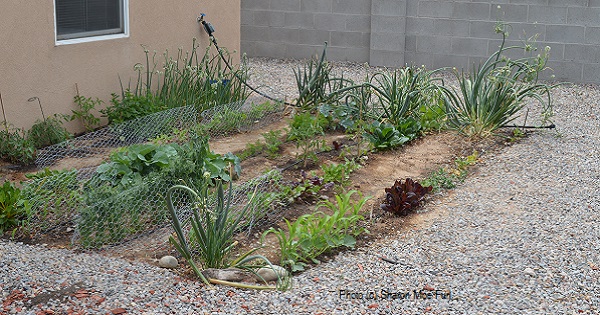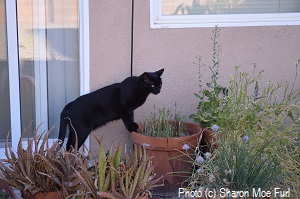|

High Desert Gardening
By Sharon Moe Furl
Having just moved to New Mexico for the purpose of a sunny inexpensive retirement, I started to plan the garden. After all, my husband and I had had a vegetable garden for the past forty years from Vermont to Texas, and I didn’t intend to retire from gardening.
We had chosen a house in central New Mexico in the high desert with a 40-foot-square backyard and approximately four-foot-high walls, all suitable for a vegetable garden. However, the ground was literally wall-to-wall decorative pebbles. I saw no sign of life at that moment, but being a persistent gardener, I saw a challenge I had not yet experienced.
First, I needed to place the vegetable garden in the best location. Having morning sun and afternoon shade would solve the problem of the intense New Mexico sun. Facing east against the stucco back wall of the house would provide good morning sun and then, by early afternoon, the necessary shade. Fortunately, along this wall was a water faucet, the life blood of a garden in the high desert. The other necessity was for the garden to be enclosed so that animals could not graze. I soon found out there was plenty of life in the form of desert rabbits. The house had black iron fencing on both sides meeting the exterior walls with a gate, so some two-foot-high chicken mesh attached to the iron fencing panel worked well.
Now came the removal of the pebbles in the 14-foot square chosen for the garden. Simply raking cleared the majority, but some hand work was required with the protection of gloves and knee pads. The soil/sand was still not visible because black landscape fabric lay under the pebbles to prevent any form of life from emerging. The fabric was then pulled up, cut away, and disposed of.
Finally, there was the soil: part clay, part sand.
Our realtor had told us, “Anything can grow in it as long as you give it water.”
Having grown up on the fertile soil of a Wisconsin dairy farm, I was skeptical so went to buy compost. We moved to New Mexico in April so had no compost of our own during our first summer. The compost pile was one of our first additions to the backyard. During the winter months, we dug vegetable scraps, fruit scraps, and crushed egg shells directly into the soil and watered them down, for only the very top soil ever froze. As I turned over the soil in the spring, I could see some lovely black compost interspersed with the clay and sand.
Just as precious as composted soil is in New Mexico, so is water. Attending local farmers markets, we soon learned ways to conserve water. Upon good advice, we installed an above-ground drip irrigation system and immediately saw an improvement in plant growth. The irrigation tubing runs directly down the garden rows, so no water is wasted between the rows. It works perfectly to run it at a very slow drip on a timer for one to two hours in the morning depending on whether or not it is monsoon season. In central New Mexico, rainfall in July through September averages one to two inches each month because it is monsoon season. However, the rainfall is usually not dependable, so it works best to manually turn off the irrigation only after an adequate amount of rain has fallen. 
We also recycle our sink water from both the kitchen and the bathroom plus any water used to boil pasta or potatoes, etc. Our one-story house with kitchen and bathroom being close to the back patio door makes it convenient to use pails to transport this water to clay pots and shrubs in areas of the backyard not located in the vegetable garden proper.
Next came choosing the right seeds and plants that were appropriate to the area. Whenever Native American heritage seeds were available, they were my first choice. Amaranth with its tiny pink and white flowers that grew almost shoulder high and Hopi Pink beans for drying were all new to me and highly successful. I also ordered seeds that were advertised as drought-tolerant and sun-loving from seed catalogs. I planted taller sun-loving vegetable plants near shorter cool-weather plants to make use of the natural shade.
Flower seeds that I have successfully grown with only a small amount of water include cosmos, sunflowers, and Mexican Zinnias. Hen and Chicks grow almost with no water when established in a sandy corner of the yard. All were started indoors on a sunny windowsill in March.
All types of tomatoes have grown very well with the seedlings planted directly in the soil. Once, I even had an indeterminate paste tomato plant that just grew up in the onions apparently compliments of the birds, for I never planted that kind of tomato.
In order to bring more life to the backyard, I went to a nearby Native American pueblo and purchased a few local shrubs that have grown well without much water once they were established. I discovered from the Santa Fe farmer’s market that herbs grow well in this area, so I bought a spearmint plant and started cilantro, chives, and garlic chives from seed. Having brought Egyptian onions from our previous garden, I planted them immediately upon our arrival before even completely cleaning the garden area. They are very happy even with pebbles still part of their soil and they supply us with fresh onions all winter.
I also put a bird feeder in our backyard and have been able to attract little redheaded finches. To make the bird feeding more natural and welcoming to all birds, I was able to grow an assortment of Native American sunflowers in a circle around the base of the feeder.
Outside the back patio door, I always keep a clay pot of wheat grass for our pet cats. The seed germinates well if soaked in water overnight. That is the only form of grass located in our yard. I feel that New Mexican water is too precious to use on a vegetation that provides no food value and no flowers but uses a great deal of water to maintain.
To welcome us to the high desert, a couple of prickly pear plants soon sprouted right out of the pebbles in the backyard. We now have a group of six plants but do pull out others that appear in the yard. It takes patience to watch their slow growth, but I can imagine the syrup or jelly I will eventually be able to make from the fruit of this cactus.
Our garden has provided us with a long summer season of fresh vegetables and also herbs, if dried or frozen, for the whole year. The high desert looks entirely different on each side of the walled yard. On the outside is sand and sagebrush and an arroyo, and on the inside is an oasis of vegetable and flowering plants that are growing with a small amount of water and much devotion.
Sharon Moe Furl received her Bachelor’s degree in Wisconsin and a Master’s degree in Texas. She has taught writing in community colleges in Illinois and Texas for over 15 years. In addition to freelance writing for magazines, she has been a freelance newspaper writer in Colorado. She now lives in New Mexico with her husband and three cats, and her 40th garden.
|

